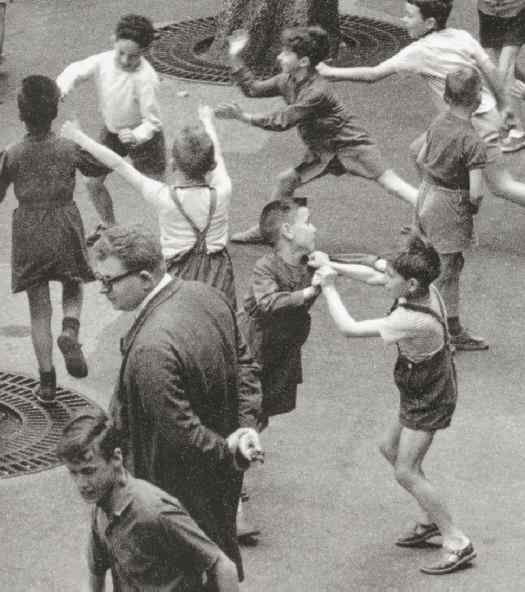
Figure 1.--This scene from a French playground in the 1950s shows representative clothing worn to schools. At this school, the boys that wore smocks mostly wore front-buttoning ones. |

|
Berets largely disappeared after World War II. Smocks were still very common in the 1940s and 50s, although less so than before th War. Smocks during the 1960s declined in popularity. After World War I, short pants which had become widely worn by the 1920s continued to be worn through the 1960s. After World War II, short cut shorts became fashionable, especially by the 1950s. Shorts were vey common in the 1940s and 50s. They were becoming, however, increasingly seasonl wear. Boy in primary schools and the younger boys in secondary school normally wore them. Shorts continued to be worn through the 1960s, but mostly by younger boys by the 1960s. In the early 1960s a few youger boys in seonday schools wore short pant, but by the end of the decade vtually all boys wore long pants to scondary school. Kneesocks were also common, although by the 1950s they had become more common in the winter than the summer. The Paris School Riots in 1968 had a significany impact on schoolwear and clothing in general.
Fashion was one of the least things on people's minds azfter World War I. In addition, the economy had been devestated by the War. Many people did not have jobs. People were wearing old clothes. Material was in short supply. Many boys were waering clothes that normally might have been discarded or handed down to a younger brother. Once the economy had begun to pick up in the late 1940s, more attention was being iven to clothing. The proisperity of the 1950s meant that more money could be spent on clothes. Boys in the 1950 cimmonly had much more extensive wardrobes than before th War. While many pre-War trends were common in the late 1940s and early 50s, notable changes were apparent by the late 1960s. Older boys less commonly ewore short pants and smocks became less commoin i schools. The Paris School Riots in 1968 had a significan impact on schoolwear and clothing in general.
Some information is available on specific garments during the post-war period.
Berets largely disappeared after World War II. They did not disappear entirely. Even by the early 1950s boys might wear them in rural areas. They were not common, however, in Paris. The principal exception were the Scouts. Berets were worn as part of Scout uniforms. They also might have been worn at a few private schools.
Smocks were still very common in the 1940s and 50s, although less so than before the War. Smocks during the 1960s declined in popularity. French boys still commonly wore school smocks after World War II (1939-45). Photographs from the 1940s and early 1950s still show
many boys in smocks. The popularity of smocks, however, began to decline by the late 1950s. This custom began to become less common in the 1960s. I have little information on this period. One indicator is newspaper advertisements. By the mid-1950s smocks advertisments showed
many diffent styles for girls, but only a few boys were pictured. Also by the 1960s, styles were changing. Smocks for little boys were still pictured in the back buttoning style, but increasingly the ones for older boys buttoned in front.
After World War I, short pants which had become widely worn by the 1920s continued to be worn through the 1960s. After World War II, short cut shorts became fashionable, especially by the 1950s. Shorts were vey common in the 1940s and 50s. They were becoming, however, increasingly seasonl wear. Boy in primary schoolmand the younger boys in secondary school normally wore them. Shorts continued to be worn through the 1960s, but mostly by younger boys by the 1960s. In the early 1960s a few youge boys in seconday schools wore short pants, but by the end of the decade virtually all boys wore long pants to scondary school. Knee socks were also common, although by the 1950s they had become more seasonal, mostly being worn in the winter and ankle socks in the summer.
Knee socks were also common, although by the 1950s they had become more seasonal, mostly being worn in the winter and ankle socks in the summer. British boys might wear kneesocks even in the summer or spring term. This was not the case in France.
Related Chronolgy Pages in the Boys' Historical Web Site
[Main Chronology Page]
[The 1880s]
[The 1930s]
[The 1940s]
[The 1950s]
[The 1960s]
[The 1970s]
[The 1980s]
Related Style Pages in the Boys' Historical Web Site
[Main school uniform page]
[Main country page]
[Long pants suits]
[Short pants suits]
[Socks]
[Eton suits]
[Jacket and trousers]
[Blazer
[School sandals]
[French catalogs]
Navigate the HBC Country School Pages
[Main French 20th century chronology school page]
[Main French school page]
[Australia]
[England]
[Germany]
[Italy]
[Japan]
[New Zealand]
[Scotland]
[United States]
Navigate the Boys' Historical Clothing Web Page
[About Us]
[Activities]
[Chronology]
[Clothing styles]
[Countries]
[Debate]
[Economics]
[Garment]
[Gender]
[Hair]
[History]
[Home trends]
[Literary characters]
[School types]
[Significance]
[Transport and travel
[Uniform regulations]
[Year level]
[Other topics]
[Images]
[Links]
[Registration]
[Tools]
[Return to the Historic Boys' School Home]
